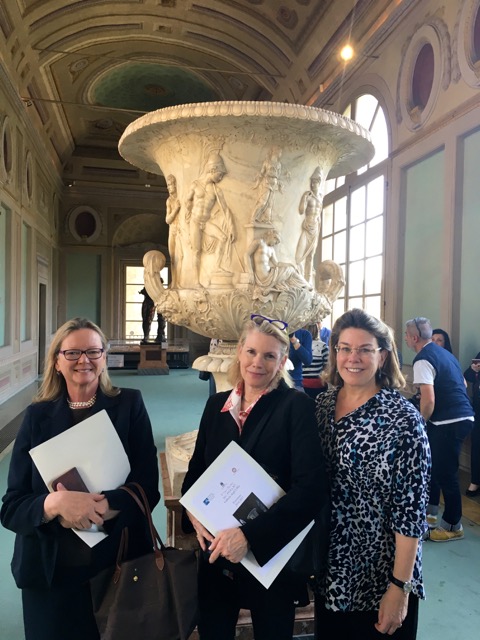The restoration was made possible thanks to the generosity
of the Friends of Florence Foundation
Today, 22 May, celebrates the unveiling of the newly restored Neo-Attic marble krater. The monumental vase, once part of the antiquities collection in the Villa Medici in Rome, entered the Uffizi in 1780. Along with the Borghese Vase, it is one of the biggest and rarest surviving examples of the items made in Neo-Attic Athens (second half of the first century B.C.) to decorate the gardens of the wealthy in Rome. The bell-shaped vase is 1.73 meters high including the base, with a diameter of 1.35 meters. The astounding frieze on the surface, that is also decorated with acanthus leaves and beading, is probably a depiction of the Athenians gathered at Delphi before the Trojan War. There are also heads of two satyrs and a female figure, presumed to be Iphigenia, crouching near the statue of Artemis. The vase, that was one of the Medicis’ archaeological treasures has been rendered in prints and reproduced in other materials.
The vase was reassembled from large fragments found at the excavation site. It has been restored at various times with varying results until this project, financed by the Friends of Florence. Thanks to the restorations done by Daniela Manna and supervised by archaeologist Fabrizio Paolucci, the vase has acquired greater uniformity and legibility. Furthermore, the restoration revealed that in ancient times it had been decorated with gold, blue and red like early statuary and other precious marble items.
The 3D mapping, done by Fabrizio Ungaro to aid the tests done prior to the restoration, also led to a better understanding of the stratification of the interventions done in various eras and made it possible to clearly distinguish the original fragments from the parts that were made later, all of which helped to fill the lacunae. Thanks to this study we can state that 90% of the vase’s components date to the Neo-Attic period (see the enclosed CD and the video on our YouTube channel, UffiziTV, or in the press area at http://www.polomuseale.
“The Medici Vase that has been admired, drawn, and analyzed by scholars and admirers of ancient art for centuries, has become more legible thanks to the restoration. The tests and studies have made a substantial contribution to understanding and appreciating this magnificent piece”, according to Eike Schmidt, Director of the Gallerie degli Uffizi.
As Simonetta Brandolini d’Adda, president of the Friends of Florence said, this project, linked to memory, also serves to connect antiquity with the present: “The restoration of the Medici Vase is a project that brought us enormous satisfaction because the work we financed made it possible to study the piece and to discover new and precious facts about its history and the artistic techniques. The project was one of the candidates in the second – 2014 – edition of the of Friends of Florence Award competition at the Salone dell’Arte e del Restauro and we are happy to have found donors fascinated by its beauty and willing to finance the restoration in honor of David Curtis. Our friends Patty and Bill Babcox, Diana Richman, Jim Abellera and Sonya and Darren Schroeder who have already supported many of our projects, wanted to dedicate this one to the memory of their dear friend who passed away in Florence.”
